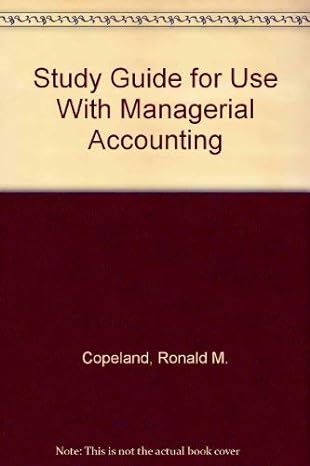Question
Remington Aeronautics LTD is a British aeronautics subcontract company that designs and manufactures electronic control systems for commercial airlines. The vast majority of all commercial
Remington Aeronautics LTD is a British aeronautics subcontract company that designs and manufactures electronic control systems for commercial airlines. The vast majority of all commercial aircraft are manufactured by Boeing in the U.S. and Airbus in Europe; however, there is a relatively small group of companies that manufacture narrow-body commercial jets. Assume for this exercise that Remington does contract work for the two major manufacturers plus three companies in the second tier.
Because competition is intense in the industry, Remington has always operated on a fairly thin 20% gross profit margin; hence, it is crucial that it manage non-manufacturing overhead costs effectively in order to achieve and acceptable net profit margin. With declining profit margins in recent years, Remington Aeronautics CEO, John Remington, has become concerned that the costs of obtaining contracts and maintain relations with its five major customers may be getting out of hand. You have been hired to conduct a customer profitability analysis.
Remington Aeronautics non-manufacturing overhead consist of $2.5 million of general and administrative (G&A) expense (including, among other expenses, the CEOs salary and bonus and the cost of operating the companys corporate jet) and selling and customer support expenses of $3 million (including 5% sales commissions and $1,050,000 of additional costs).
The accounting staff determined that the $1,050,000 of additional selling and customer support expenses related to the following four activity cost pools:
| Activity | Cost Driver | Cost per Unit of Activity | |
| 1 | Sales Visit | Number of visits | $1,400 |
| 2 | Product adjustment | Number of adjustments | $1,200 |
| 3 | Phone and email contacts | Number of calls/contacts | $200 |
| 4 | Promotion and entertainment events | Number of events | $1,600 |
Financial activity data on the five customers follows (Sales and Gross Profit data in millions):
| Quantity of Sales and Support Activity | ||||||
| Customer | Sales | Gross Profit | Activity 1 | Activity 2 | Activity 3 | Activity 4 |
| A | 17 | 3.4 | 106 | 23 | 220 | 82 |
| B | 12 | 2.4 | 130 | 36 | 354 | 66 |
| C | 3 | .6 | 52 | 10 | 180 | 74 |
| D | 4 | .8 | 34 | 6 | 138 | 18 |
| E | 3 | .6 | 16 | 5 | 104 | 10 |
| 39 | 7.8 | 338 | 80 | 996 | 250 | |
In addition to the above, the sales staff used the corporate jet at a cost of $800 per hour for trips to the customers as follows:
| Customer A | 24 hours |
| Customer B | 36 hours |
| Customer C | 5 hours |
| Customer D | 0 hours |
| Customer E | 6 hours |
The total cost of operating the airplane is included in general and administrative expense; none is included in selling and customer support costs.
Required
a. Prepare a customer profitability analysis for Rogers Aeronautics that shows the gross profits less all expenses that can reasonably be assigned to the five customers
b. Now assuming that the remaining general and administrative costs are assigned to the five customers based on relative sales dollars, calculate net profit for each customer.
c. Discuss the merits of the analysis in part a, versus part b.
Step by Step Solution
There are 3 Steps involved in it
Step: 1

Get Instant Access to Expert-Tailored Solutions
See step-by-step solutions with expert insights and AI powered tools for academic success
Step: 2

Step: 3

Ace Your Homework with AI
Get the answers you need in no time with our AI-driven, step-by-step assistance
Get Started


